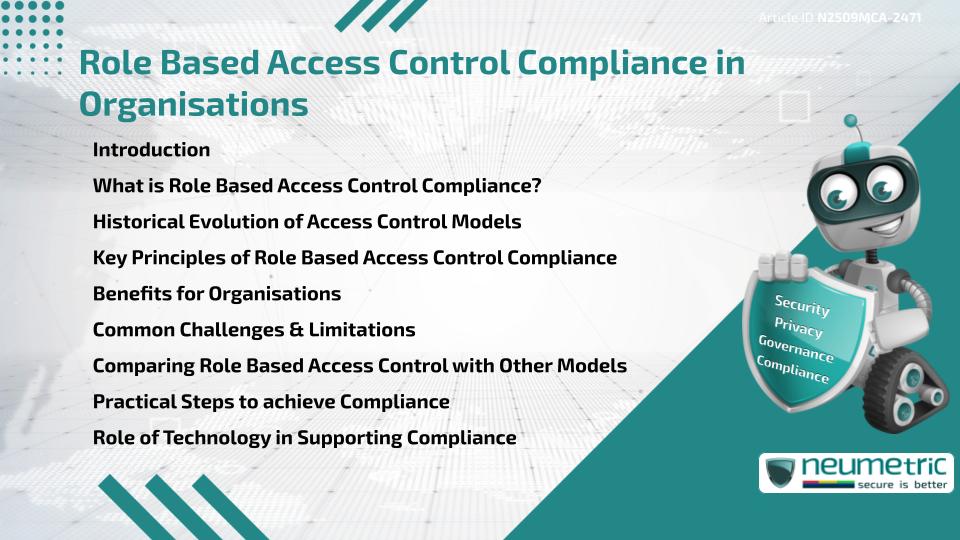Table of Contents
ToggleIntroduction
Role based Access Control Compliance ensures that organisations manage User permissions according to established Policies & Regulatory Standards. By assigning access based on roles rather than individuals, it streamlines security, reduces Risks of data misuse & enhances Accountability. Organisations that adopt this Compliance model not only protect Sensitive Information but also demonstrate adherence to Industry Regulations, supporting Trust & operational Efficiency.
What is Role Based Access Control Compliance?
Role based Access Control Compliance is the practice of aligning role-based permissions with legal, regulatory & organisational requirements. Under this approach, Employees are granted access to resources based on their job functions.
For example, a Finance officer may access Financial records but not engineering designs, while an IT administrator can manage systems without viewing confidential HR data. Compliance ensures that these permissions are structured, monitored & auditable.
Historical Evolution of Access Control Models
Access Control began with Discretionary Access Control [DAC], where individual users determined who could access their data. This system was flexible but inconsistent. Later, Mandatory Access Control [MAC] emerged, often used in military environments, enforcing strict centralised Policies.
Role based Access Control [RBAC], introduced in the 1990s, provided a balanced solution. It combined flexibility with consistency by assigning permissions to roles rather than individuals. Over time, role based Access Control Compliance became a regulatory expectation in industries handling Sensitive Data, such as Healthcare & Finance.
Key Principles of Role Based Access Control Compliance
Several principles underpin role based Access Control Compliance:
- Least Privilege: Users have only the access needed to perform their job.
- Separation of Duties: Critical tasks are divided among roles to prevent fraud or error.
- Accountability: Access activities are logged for Monitoring & Audits.
- Scalability: Roles can adapt to organisational changes without excessive administrative burden.
- Consistency: Policies ensure uniform application of access rules across the organisation.
These principles create a secure, auditable & manageable access Framework.
Benefits for Organisations
Implementing role based Access Control Compliance provides numerous benefits:
- Stronger protection of Sensitive Data
- Simplified User management through role assignments
- Reduced Risks of insider Threats & Errors
- Enhanced ability to meet Regulatory requirements
- Improved Audit readiness & transparency
For organisations, Compliance is both a safeguard & a tool for operational efficiency.
Common Challenges & Limitations
Despite its strengths, organisations face challenges when applying role based Access Control Compliance:
- Role Explosion: Too many granular roles can complicate management.
- Dynamic Environments: Frequent changes in job functions require ongoing adjustments.
- Implementation Complexity: Large organisations may struggle with initial design & rollout.
- Cultural Resistance: Employees may view restrictions as obstacles to productivity.
Balancing security with usability is a recurring challenge in Compliance.
Comparing Role Based Access Control with Other Models
Compared to discretionary or mandatory Access Control, role based Access Control Compliance offers a more practical balance of flexibility & oversight.
Think of DAC as giving Employees the keys to their desks, MAC as requiring every drawer to be centrally locked & RBAC as issuing keys based on job functions. The Compliance element ensures that these keys are distributed & monitored according to defined rules & legal requirements.
Practical Steps to achieve Compliance
Organisations can implement role based Access Control Compliance through these steps:
- Define roles & responsibilities clearly across departments.
- Map permissions to roles, following the principle of least privilege.
- Establish Policies for separation of duties.
- Train Employees on Compliance & Security practices.
- Deploy monitoring systems to Log & Audit access.
- Review & update roles regularly as business needs evolve.
These steps provide a clear pathway to achieving sustainable Compliance.
Role of Technology in Supporting Compliance
Technology is central to enforcing role based Access Control Compliance. Tools such as identity & access management [IAM] systems, Multi-Factor Authentication & Audit software help automate processes, monitor activity & provide Evidence for Regulators.
Automation reduces human error, ensures consistency & enables real-time detection of violations, strengthening Compliance across complex environments.
Takeaways
- Assigns access based on job roles, not individuals
- Reduces Risks of data misuse & insider Threats
- Ensures accountability through Logging & Audits
- Supports Compliance with Regulatory Standards
- Scales efficiently with organisational changes
FAQ
What is role based Access Control Compliance?
It is the alignment of role-based access management with organisational & regulatory requirements to secure Systems & Data.
Why is role based Access Control Compliance important?
It reduces Risks, ensures Regulatory adherence & streamlines management of User permissions.
How does it differ from other Access Control models?
Unlike discretionary or mandatory models, role based Access Control Compliance provides a balance between flexibility & oversight.
What are the key principles of Compliance?
Key principles include Least Privilege, Separation of duties, Accountability, Scalability & Consistency.
What challenges do organisations face?
Challenges include role explosion, implementation complexity, frequent role changes & cultural resistance.
Can automation help with Compliance?
Yes, IAM tools & Audit systems automate role Assignments, Monitoring & Reporting, making Compliance more effective.
How often should access roles be reviewed?
Roles should be reviewed regularly, ideally quarterly & whenever job responsibilities change.
Need help for Security, Privacy, Governance & VAPT?
Neumetric provides organisations the necessary help to achieve their Cybersecurity, Compliance, Governance, Privacy, Certifications & Pentesting needs.
Organisations & Businesses, specifically those which provide SaaS & AI Solutions in the Fintech, BFSI & other regulated sectors, usually need a Cybersecurity Partner for meeting & maintaining the ongoing Security & Privacy needs & requirements of their Enterprise Clients & Privacy conscious Customers.
SOC 2, ISO 27001, ISO 42001, NIST, HIPAA, HECVAT, EU GDPR are some of the Frameworks that are served by Fusion – a SaaS, multimodular, multitenant, centralised, automated, Cybersecurity & Compliance Management system.
Neumetric also provides Expert Services for technical security which covers VAPT for Web Applications, APIs, iOS & Android Mobile Apps, Security Testing for AWS & other Cloud Environments & Cloud Infrastructure & other similar scopes.
Reach out to us by Email or filling out the Contact Form…


